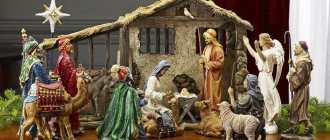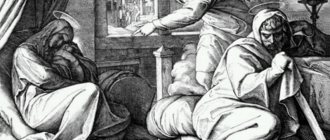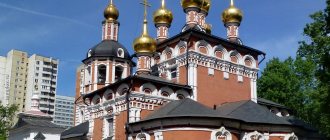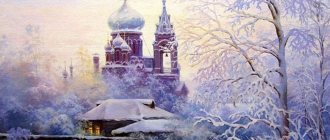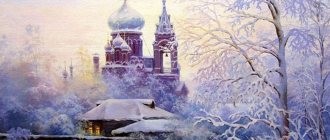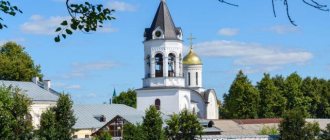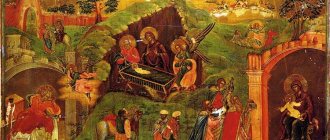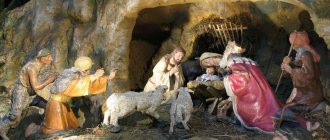During the reign of the pagan Roman emperor Julian the Apostate, the disciples of the prophet Daniel came to the market to buy food. Having learned that fasting Christians had gathered to buy food, the ruler decided to show off on them.
To do this, he ordered all the food in the market to be sprinkled with the blood of animals sacrificed to idols. In order to prevent the consumption of a defiled pagan meal, the prophet Daniel ordered his novices to eat soaked grains and dried fruits. Since then, on Christmas Eve, believers eat sochi, in memory of these events.
Christmas Eve is a day of intensive preparation for the holiday of the Nativity of Christ
Christmas Eve is the eve of the Nativity of Christ. It is celebrated on December 24 (January 6) in churches that adhere to the Gregorian and New Julian calendars. However, some Orthodox churches, including the Russian Orthodox Church, as well as Greek Catholics celebrate it on a different day.
This is due to the fact that they celebrate the Nativity of Christ on December 25 according to the Julian calendar (old style). As a result, the day falls on January 7th according to the Gregorian calendar and Christmas Eve occurs on January 6th.
The Eve of Epiphany. Gethsemane Chernigov Skete. In Orthodoxy, Christmas Eve is celebrated on December 24 (January 6)
At the end of the 3rd - beginning of the 4th centuries, Christians began to celebrate Christmas and the Baptism of the Savior on the same day - January 6, under the general name of Epiphany. This tradition is still followed by the Armenian Apostolic Church.
Only in the middle of the 4th century did the Roman Church begin to celebrate the Nativity of Christ on December 25, separately from the Epiphany.
Christians began to celebrate Christmas and Epiphany together at the end of the 3rd - beginning of the 4th centuries.
The purpose of Christmas Eve is preparation for the feast of the Nativity of Christ. Many people don’t know what the word “Christmas Eve” means. It comes from the Old Russian “sochnnik” and “sochenya”.
Other names for the holiday: Holy Eve, Sochevnik, Eve of the Nativity of Christ, Kolyada, Christmas Eve. Sochenya are flatbreads made with hemp oil. They were baked for Christmas, and masks were made from the dough. Through such masks they looked at passers-by and judged the future by their appearance.
Sochivo - the main dish of Christmas Eve
Not many people know what sochenya is these days. Usually this is a food consisting of wheat, nuts and honey - sochiva. In some cases, these are flatbreads prepared according to a special recipe. As for sochik, it is prepared from wheat, nuts and honey.
The tradition of eating this dish on Christmas Eve appeared in memory of Daniel and the three youths, who, according to the Gospel, “ate from the seeds of the earth, so as not to be defiled by a pagan meal.”
How this day is celebrated in other countries
Christmas Eve is a holiday revered in the church. Not only the Orthodox, but also the Greek Catholic Church celebrates it on January 6th. This is what the Julian calendar dictates. After Christmas Eve comes Christmastide. Nowadays, the custom is observed only in villages. The traditions associated with this period will be discussed later.
Those states that have adopted the Gregorian calendar also celebrate Christmas Eve. Only this holiday falls on December 24th there. The celebration is named in different countries according to their language. For example, in Slovenia, Christmas Eve is called Sveti veer, and in Ukraine - Svyatvechir, in Montenegro, Bosnia and Herzegovina and Serbia they celebrate Badnjak (Badnidan), and in Bulgaria - Budni Vecher.
The celebration of the eve of the Nativity of Christ was established in the 4th century
The Eve of the Nativity of Christ began to be celebrated in the Orthodox Church in the 4th century. The sacred hymns used for Christmas services were written in the 5th-8th centuries. During this period, the Royal Hours were celebrated in churches. They proclaimed many years to the Tsar, his house, and also to all Orthodox Christians.
Adoration of the Magi. Fresco in the Church of St. Mark in Milan. Unknown artist. 17th century Orthodox Christians fast on Christmas Eve until the appearance of the first star in honor of the appearance of the Star of Bethlehem, which announced the birth of the Savior
On the day before Christmas or Christmas Eve, Orthodox Christians refuse to eat until the first star appears. In Slavic languages it is called Vechernitsa and means the evening star Venus.
The ancients did not know that it was a planet and because of the brightness of its glow they called it a star. The planet appears in the sky after sunset and very often glows along with the moon.
The “first star” usually means the planet Venus, which appears in the sky first.
The emergence of the very tradition of fasting “until the first star” is associated with the legend about the appearance of the Star of Bethlehem. This star announced the birth of Christ. That is why it is given great importance in Christianity, although the Church Charter does not say a word about it.
Orthodox Christians break their fast with sochivom or kutya. It consists of soaked wheat grains with honey and fruits.
Polish Christmas Eve wafer. In Eastern European countries, wafers (Christmas bread) are broken on Christmas Eve.
As for Catholicism, historically it has happened that Christmas Eve is not obligatory for Catholics. Usually Catholics gather in their families in the evening for a solemn meal. A set of Lenten dishes is placed on the festive table, and before the meal begins, a passage from the Gospel about the birth of Jesus Christ is read.
In Eastern European countries, there is a custom of breaking wafers (Christmas bread) at this meal. In both Catholicism and Orthodoxy, after finishing the family meal, believers go to the temple for the evening service of the Nativity of Christ.
Catholic tradition
Strict fasting is celebrated only in Orthodoxy. In Catholicism, it is not obligatory, but desirable. In Europe, Christmas Eve is celebrated with family, gathering all relatives at one table. They still feast on Lenten dishes, since the main holiday has not yet arrived. Starting the meal, the head of the house takes the floor. It is customary to read the Gospel, namely, the part where Christmas is described. And only then can you start eating.
According to tradition, one place is empty at the table and there is a device in case of a sudden guest. Catholics prepare wafers for this holiday in advance. These are special breads made from rye flour. They are crumbled and served to guests. Anyone who eats such bread thanks everyone present, wishing them well.
On Christmas Eve, services are held in all Christian churches, regardless of denomination.
Epiphany Eve is also notable for the fact that on this day services take place in all Christian churches, regardless of denomination. This is how the Orthodox serve the Great (Royal) Clock. The Gospel is read on them, as well as a short sequence of the “Fine”.
At this time, the clergy from the pulpit read the entrance prayers and dress for the Great Supper with the reading of proverbs in conjunction with the Liturgy of St. Basil the Great. In addition, on Epiphany Eve at the end of the liturgy after the prayer behind the pulpit, the Great Blessing of Water is performed.
Video: Sermon of Patriarch Kirill on Christmas Eve. At 34 seconds the author talks about the order of worship on Christmas Eve.
If Christmas Eve (both Christmas and Epiphany) falls on Saturday or Sunday, then the service of the Royal Hours with the Fine Hours and Great Vespers is moved to Friday.
In this case, the liturgy is not added to them (that is, on Friday the liturgy is not performed in principle); on Christmas Eve itself, in this case, the liturgy of St. John Chrysostom is served (the Blessing of Water on Epiphany Eve is still performed). On Christmas Day itself, in this case, the Liturgy of St. Basil the Great is served.
Previously, kings and emperors were present at the service of the Royal Hours.
On Christmas Eve, Catholics celebrate Mass in the morning according to the rite of Advent. The Christmas Eve Mass begins after dark, usually at midnight, but for pastoral reasons it is permitted to begin the service a few hours earlier. In Poland and some other Eastern European countries it is called pastoral or "pastorka".
Video: Good Friday Royal Hours in the Church of the Life-Giving Trinity in Trinity-Golenishchev. At 35 seconds the service begins with exclamations: “Lord have mercy! Lord have mercy! Lord have mercy!".
As for Protestants, they do not celebrate the Eucharist on Christmas Eve. The entire service is reduced to the singing of hymns, prayers of praise, biblical readings (especially chapter 2 of the Gospel of Luke) and sermons.
Instead of the Apostles' Creed, the Nicene Creed is read. Instead of the Apostolic Epistles, the Old Testament is read. At the end of the mass, the pastor brings out a makeshift manger with a doll representing the baby Jesus.
On Christmas Eve, folk traditions are combined with Christian ones.
Orthodox traditions on Christmas Eve are combined with folk traditions. For example, many Orthodox Christians prepare 12 Lenten dishes for this holiday and go to visit with treats; guess; They use a talisman (“didukh”). At the same time, they attend services in churches: all-night vigil and liturgy.
12 Lenten dishes served on Christmas Eve except Sochiv. This number symbolizes the 12 apostles of Christ
On this day, the house is thoroughly cleaned and various rubbish is thrown away. Some householders pay special attention to the decoration of the Christmas table, for example, they place a bunch of hay under the table - a symbol of the Christmas manger.
6 to 7 January
on Epiphany Eve, young people tell fortunes, although the Church condemns this
On the night of January 6-7, fortune telling is common among young people. The Church condemns such customs, but they are still preserved among the people. In addition, on Christmas Eve you should ask for forgiveness from the people who were offended, and forgive all your enemies. This can be called a truly Christian matter.
Winter evening. I.S. Kulikov. 1907 On Christmas Eve, many people tell fortunes. The Church condemns this, the Orthodox should always remember this
In addition, it is not advisable to work on Christmas Eve in order to prepare spiritually for the celebration of the Nativity of Christ. On this holiday you cannot quarrel and sort things out. In addition, there is no need to be greedy or otherwise behave in a way that is not appropriate for a Christian.
Signs
When Christmas Eve arrived, they took a wax candle and whispered a fortune-telling spell: “Burn, candle, righteous sun, shine for the souls in paradise and for us, the living, warm Mother Earth, our cattle, our fields.” If the flame burns evenly and calmly - to the harvest and all prosperity and good luck, but if it fluctuates and rushes about - do not expect a good offspring.
As it was getting dark, we looked at the sky. With a clear sky and many stars, they looked forward to a summer full of berries, generous, and cows, pigs and goats would bear a lot of offspring.
Snowstorms before Christmas Eve were a good sign for bees; there would be plenty of honey.
Christmas Eve is celebrated in the very middle of the harsh winter - January 6th. But this time of year in central Russia is changeable. Thaws are also common. It has been noticed that if drops suddenly begin, as if spring has arrived and everything is melting, such a phenomenon is not good for anything, the vegetables will not grow. But there is hope to collect a lot of buckwheat. And if the trees are covered with frost, then there will be a good harvest of bread.
Christmas Eve is the strictest day of the 40-day Advent fast.
When preparing for the bright holiday of the Nativity of Christ, it is necessary to remember that January 6 is the strictest day of the forty-day Nativity Fast. This is why believers are only allowed to drink water. Only after the first star appears in the sky can you break your fast. Sometimes this dish is replaced with kutya.
Prophet Daniel in the ditch. Mosaic at Osios, 12th-13th centuries. Orthodox Christians eat sochi on Christmas Eve in imitation of the prophet Daniel, who began to eat this dish in order not to eat a pagan meal.
It is used sochivo on this day, imitating the biblical prophet Daniel. The Holy Scriptures tell a parable about how the pagan Julian the Defiant ordered all the food in the market to be sprinkled with the blood of animals sacrificed to idols.
He did this in order to mock Christians. In order to avoid accepting a defiled pagan meal, the prophet Daniel ordered his novices to eat soaked grains and dried fruits. In addition, you can use sochivo based on the following words of the Gospel:
(Matthew 13:31-36)
“The kingdom of heaven is like a mustard seed, which a man took and sowed in his field, which, although smaller than all the seeds, when it grows, it is larger than all the grains and becomes a tree, so that the birds of the air come and take refuge in its branches.”
Video: in the first minute and six seconds, the author talks about what juicy is.
To prepare sochiva take: Ingredients: 1 glass of wheat grains, 100 g of poppy seeds, 100 g of walnut kernels, 1-3 tablespoons of honey, sugar to taste. Preparation procedure: Wheat grains are pounded in a wooden mortar, adding a little warm water so that the wheat shell comes off.
The kernel is then separated from the husk by sifting and washing. Next, cook the usual crumbly lean porridge in water. At the same time, grind the poppy seeds to obtain milk of the poppy seeds, add honey, mix everything and add to the wheat. At the end crushed walnut kernels are added.
How to prepare for Christmas Eve
As already mentioned, the holiday falls on a post called “Christmas” and begins on November 28. Therefore, they strictly abstained from eating meat. During these five weeks, they also did not consume other fast foods, such as eggs, ghee and butter, kefir, cottage cheese, sour cream, all milk products, and fish. They ate plant foods: potatoes and mushrooms, pickles and urine, turnips, cereal porridges with water, bread and kvass.
Christmas Eve was preceded by cleaning. The whole house had to be put in order, washed and even the farthest corners cleaned. We washed ourselves in a hot bathhouse and put on smart clothes. Not only the body, but also the thoughts needed to be cleansed. Before the festive meal, they prayed in front of the icons, lit candles, and thanked God.
For the Slavs, the holidays begin on Christmas Eve
In addition to sochiv, according to folk custom, on Christmas Eve after the first star, 12 more dishes are eaten. They represent the 12 apostles. This includes baked fish, vegetable salads and stews, mushroom soup, Lenten borscht, pampushki, pies, dumplings, cabbage rolls with mushrooms, and pickles.
No alcohol is consumed on Christmas Eve. The traditional drink of this day is uzvar made from dried fruits and honey. The combination of kutya and uzvar on tables is a symbol of eternal life, the birth and death of Jesus.
Video: Archpriest Andrey Tkachev. How to prepare for Christmas. At 20 seconds, the author says that Christmas Eve is the day on which you can prepare as much as possible for Christmas.
In Slavic countries, Christmas Eve begins the holidays, that is, two weeks of winter holidays. They continue until the Epiphany of the Lord on January 6 (19). Christmastide in the folk Slavic tradition is a folk holiday cycle consisting of twelve holiday days.
It begins from the appearance of the first star on Christmas Eve until the baptismal blessing of water. In the Christian tradition, Christmastide refers to the time from the Nativity of Christ until the Epiphany.
The church began to celebrate 12 days after the feast of the Nativity of Christ in ancient times. The Second Council of Turon in 567 designated all days from the Nativity of Christ to Epiphany as holidays. At this time, it is forbidden to perform the sacrament of marriage.
At Christmas time there are performances in the Nativity scene
Immediately after Christmas Eve, on Christmastide, performances take place in the Nativity scene. The Nativity scene (the original meaning is a cave, a hidden place) is a representation of the scene of the Nativity of Christ through the means of various arts (sculpture, theater, etc.).
During the Russian Empire, the “vertep theater” spread widely throughout Poland, Ukraine and Belarus. It was a folk puppet theater that staged Christmas scenes.
Nativity scene with full-length figures in Rüdesheim am Rhein. In Russia, Christmas nativity scenes were also popular, especially in the western provinces
A special box was called a nativity scene in such a theater. It showed the puppet show itself.
Inside, it consisted of a two-tier stage: in the upper part they showed the worship of the newborn baby Jesus, in the lower part there were episodes with Herod, after whose death the everyday part of the performance followed.
The nativity playhouse box has a two-tier stage.
The nativity play theater had several varieties, including large and small forms, as well as nativity scenes with sculptures and actors. The main decoration of this theater is a manger with the baby Jesus.
The main characters of the nativity theater are the righteous Joseph with a long beard, the Holy Virgin Mary and King Herod. Also present in the nativity scene were wise men, angels, shepherds with sheep and various animals (for example, an ox and a donkey, which, according to legend, warmed Jesus with their breath).
Adoration of the Magi. Fresco of a cave church, Cappadocia. XII century. The Magi’s adoration of the infant Christ is a common theme in Christmas nativity scenes.
On Christmas Eve, Orthodox Christians remember the Gospel story about the worship of the Magi from the East to the Infant Christ. Eastern sages brought gifts to the Newborn: gold, incense and myrrh. Gold was brought to Christ as a King, incense - as to God, and myrrh - as a Man for burial.
By leaving a comment, you accept the user agreement
